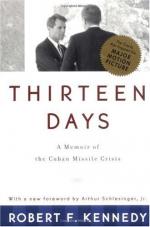|
This section contains 2,741 words (approx. 7 pages at 400 words per page) |

|
Thirteen Days, pgs. 106-150 Summary and Analysis
Richard E. Neustadt and Graham T. Allison's Afterword analyses the Cuban missile crisis on three levels: 1) how humans control the power to destroy humankind; 2) how the American presidency works in microcosm; and 3) how the roles of Congress and the Presidency relate in time of war (the great question of the 1970s). During this crisis, JFK decides and informs congressional leaders two hours before acting. Pres. Johnson obtains minimal congressional consent through the Gulf of Tonkin Resolution before committing to the longest war in U.S. history. Nixon as Commander-in-Chief invades Cambodia, ostensibly to protect U.S. troops. This then provokes a constitutional debate about war making.
In Oct. 1962, JFK chooses the path that offers a one in three change of nuclear war. Five years later, RFK wonders under what circumstances a government has the moral...
(read more from the Thirteen Days, pgs. 106-150 Summary)
|
This section contains 2,741 words (approx. 7 pages at 400 words per page) |

|




